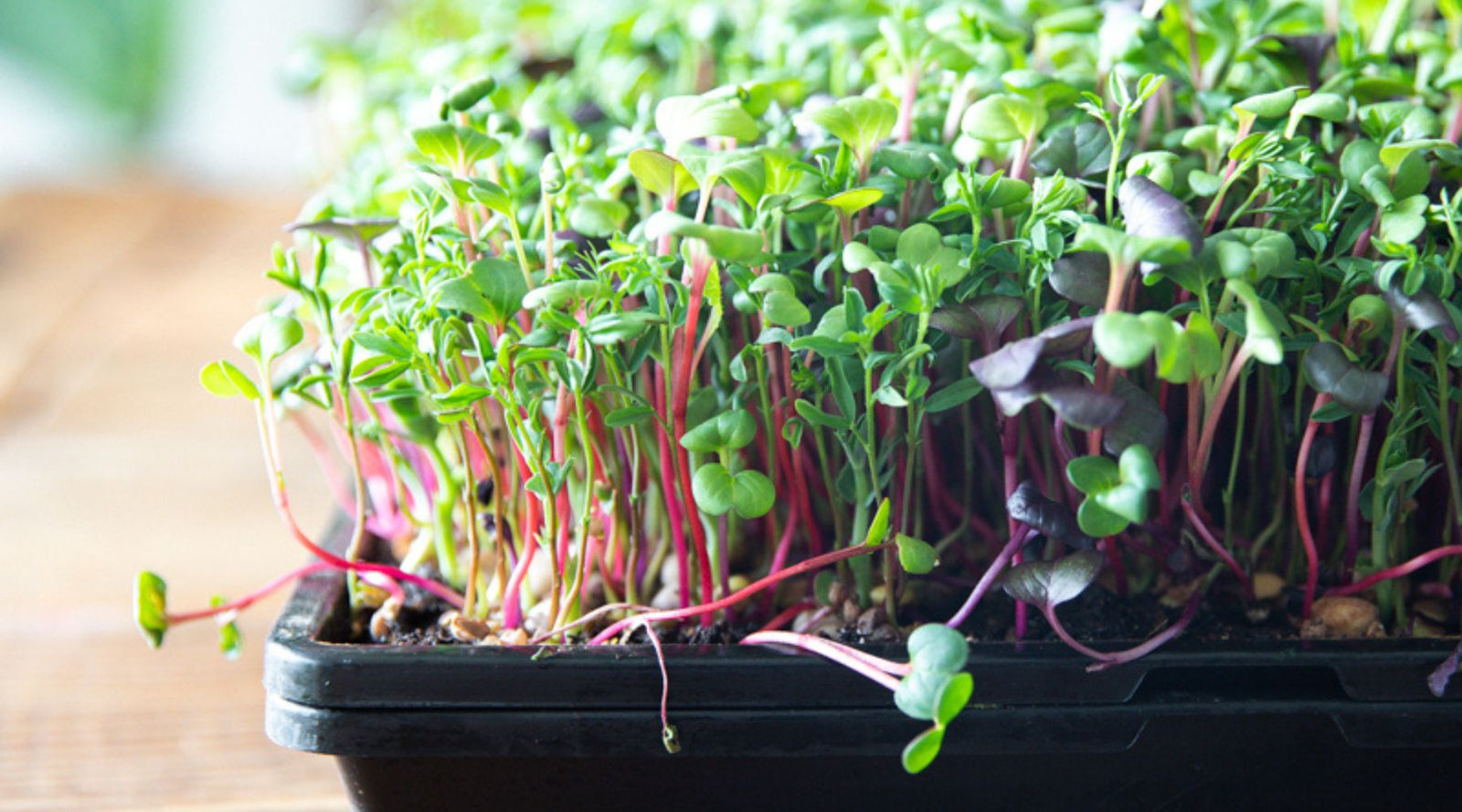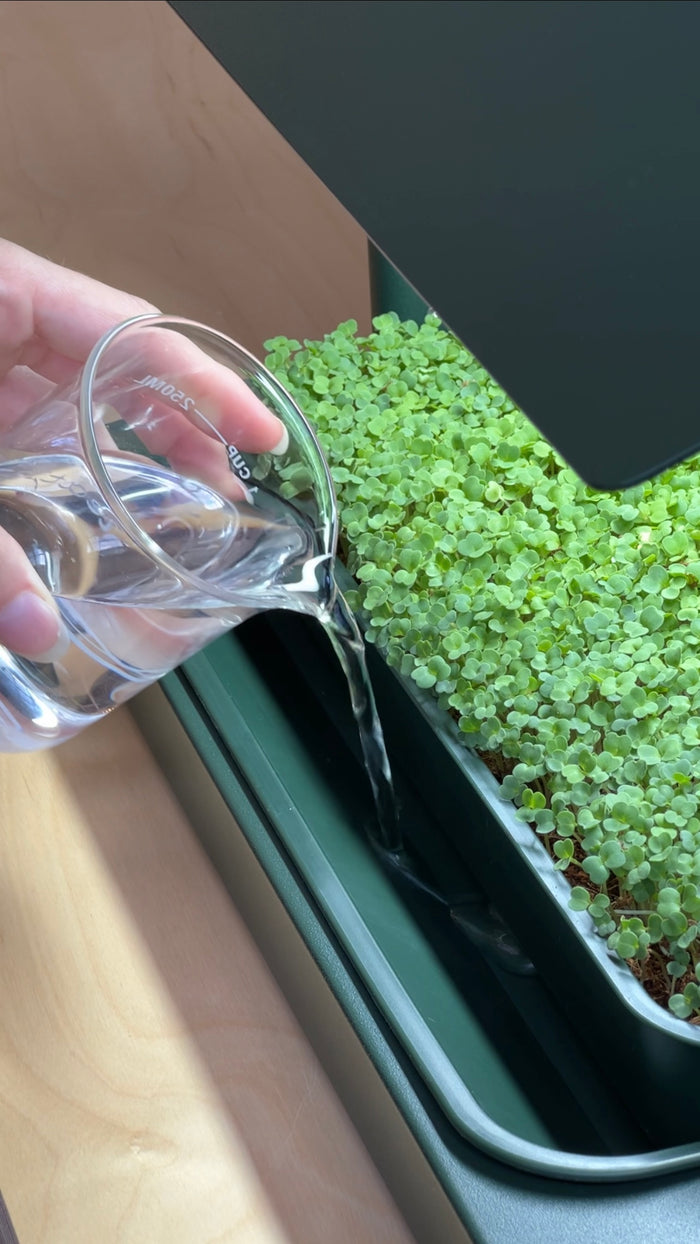To water microgreens, gently spray the soil with water until it is moist but not saturated.

Credit: thistledownsfarm.com
Why Watering Is Important For Microgreens
Microgreens are delicate and fast-growing plants that require careful attention to their watering needs. Proper watering is essential for the development of healthy microgreens. Watering is a critical aspect of microgreens care, as it directly impacts their growth, flavor, and overall quality.
Watering Needs Of Microgreens
Microgreens have unique watering requirements due to their rapid germination and growth. They need consistent moisture to thrive but are vulnerable to overwatering, which can lead to root rot and mold development. It is essential to find the right balance to ensure optimal growth without causing water-related issues.
Importance Of Proper Watering
Proper watering is crucial for the success of microgreens. It supports their essential physiological processes, such as nutrient absorption and photosynthesis. Additionally, adequate watering helps in maintaining the desired flavor, texture, and nutritional content of microgreens, making them a valuable addition to any culinary dish.
When To Water Microgreens
Watering microgreens is a crucial step in their growth process. To ensure healthy development, water them regularly, keeping the soil moist but not flooded. It’s important to provide consistent moisture without overwatering, giving your microgreens the best chance to thrive.
Microgreens, the flavorful and nutrient-packed miniature versions of vegetables and herbs, require proper care to reach their full potential. Understanding when and how to water your microgreens is crucial for their growth and overall health. In this blog post, we will discuss the importance of watering microgreens at the right time, focusing on the early stages of growth, signs of dryness, and frequency of watering.
Early Stages Of Microgreen Growth
During the early stages of microgreen growth, it is vital to provide them with adequate moisture. These tiny plants depend on water to germinate and establish strong root systems. You should water the growing medium, such as soil or a growing pad, before sowing the seeds. Moisture in the growing medium will create an ideal environment for seed germination.
Signs Of Dryness
To ensure healthy growth, it’s crucial to monitor the moisture level of your microgreens. Signs of dryness include wilted or drooping leaves, yellowing, or slow growth. Dry microgreens are more prone to stress and may become more susceptible to diseases or pests. Regularly check the moisture content of the growing medium by slightly pressing your finger into it. If it feels dry, the microgreens need watering.
Frequency Of Watering
The frequency of watering microgreens depends on various factors, such as the type of microgreen, temperature, humidity, and the growing medium used. As a general rule, water your microgreens when the top layer of the growing medium feels slightly dry. Avoid overwatering, as it can lead to root rot and other issues. Remember, each microgreen variety may have specific watering needs, so it’s important to research and adapt accordingly.
To maintain consistent moisture levels, consider misting your microgreens using a spray bottle. This gentle technique helps prevent disturbing the delicate plants and ensures even distribution of water. You can also use a watering can with a fine rose attachment to avoid excessive water pressure that might damage the microgreens.
In conclusion, watering microgreens at the right time is essential for their overall health and development. Understanding the early stages of growth, being aware of signs of dryness, and adjusting the frequency of watering accordingly will help you nurture vibrant and thriving microgreens. With proper care and attention, you can enjoy a bountiful harvest of delicious and nutritious microgreens right at your fingertips.
How to Water Microgreens : Step by Step Guide
When it comes to growing microgreens, proper watering is essential for their success. Watering microgreens correctly ensures that they receive enough moisture while avoiding issues such as overwatering. In this section, we will discuss the various methods of watering microgreens and provide tips on how to do it effectively.
Using A Watering Can Or Spray Bottle
One common method of watering microgreens is using a watering can or spray bottle. This allows you to control the amount of water you apply and target it directly at the soil surface without disturbing the delicate greens. Here’s how you can use this method:
- Fill a watering can or spray bottle with clean water.
- Hold the watering can/bottle slightly above the soil surface, ensuring that the water reaches the roots without splashing on the leaves.
- Slowly pour or spray the water over the soil, covering it evenly.
- Observe the microgreens to ensure they are properly hydrated.
- If needed, add more water until the soil is moist, but not waterlogged. You can test the soil moisture by gently pressing it with your finger.
Watering From Above Or Below
Another aspect to consider is whether to water microgreens from above or below. Here are the differences between the two methods:
| Watering from Above | Watering from Below |
|---|---|
| Mimics natural rain, providing moisture to the leaves and soil surface. | Directs water to the roots, minimizing the risk of fungal diseases. |
| Requires careful application to avoid water pooling or damaging delicate leaves. | Needs a proper drainage system to prevent water stagnation. |
| Can wash away any loose soil or seeds. | Requires less frequent watering as the soil retains moisture longer. |
Choose the watering method that works best for your microgreens based on your specific setup and preferences. Some growers even combine both methods by initially watering from above and then allowing the excess water to be absorbed by the tray or container from below.
Avoiding Overwatering
While proper hydration is crucial for microgreens, it is equally important to avoid overwatering. Overwatering can lead to issues such as root rot, mold growth, and stunted growth. Here are some tips to prevent overwatering:
- Allow the soil to dry slightly between watering sessions, as microgreens prefer slightly moist rather than constantly saturated soil.
- Check the soil moisture by inserting your finger into the soil. If it feels damp, hold off on watering.
- Monitor the drainage and make sure that excess water can escape easily. If you notice pooling or waterlogged soil, adjust your watering routine.
By following these guidelines, you can ensure that your microgreens receive the right amount of water, promoting healthy growth and minimizing the risk of water-related issues.

Credit: www.youtube.com
Best Practices For Watering Microgreens
Watering microgreens requires a delicate balance. To prevent mold and encourage healthy growth, mist the soil regularly without saturating it. Proper drainage is essential to prevent waterlogging. Remember to use room-temperature water, and water the plants evenly to ensure they thrive.
Maintaining Consistent Moisture
Microgreens need consistent moisture to thrive. Water them regularly, ensuring the soil is consistently damp, but not waterlogged. Avoid letting the soil dry out completely, as this can hinder germination and growth.
Monitoring Moisture Levels
Regularly monitor the moisture levels of the soil. Check the humidity and adjust your watering schedule accordingly. Use your finger to feel the top layer of the soil to ensure it’s not drying out.
Using Filtered Or Non-chlorinated Water
It’s vital to use filtered or non-chlorinated water when watering your microgreens. Chlorinated water can be harmful to the delicate seedlings. Filtered water ensures that your microgreens receive the purest form of hydration.
Common Mistakes To Avoid
When it comes to growing microgreens, proper watering is essential for their healthy development. However, even the most experienced gardeners can sometimes make common mistakes that hinder the growth of these delicate greens. To help you avoid these pitfalls, let’s take a look at three common errors to steer clear of: overwatering microgreens, underwatering microgreens, and watering with cold water.
Overwatering Microgreens
One of the biggest mistakes you can make when it comes to watering microgreens is overwatering them. While it’s important to keep the soil moist, excessive water can lead to a variety of issues. Overwatering can hinder oxygen flow to the roots, promote the growth of mold and fungus, and even cause the roots to rot. To prevent this, make sure not to drown your microgreens by providing them with just the right amount of water.
Underwatering Microgreens
On the other hand, underwatering microgreens is another mistake that can have detrimental effects on their growth. Microgreens require a consistent level of moisture to thrive, so failing to provide enough water can result in stunted growth and withered leaves. To avoid this mistake, regularly check the moisture level of the soil and ensure it remains adequately hydrated.
Watering With Cold Water
Believe it or not, the temperature of the water you use to water your microgreens can make a difference. Watering with cold water can shock the plants and slow down their growth. Instead, opt for room temperature water or even warm water to give your microgreens the best chance of flourishing. Just like humans, microgreens prefer a gentle and comfortable environment to grow in.
To summarize, overwatering and underwatering microgreens, as well as using cold water, are common mistakes to avoid when watering microgreens. By ensuring you strike the right balance in your watering routine, you’ll provide your microgreens with the optimal conditions for healthy and productive growth.

Credit: www.bootstrapfarmer.com
Frequently Asked Questions For How To Water Microgreens
How Often Should I Water Microgreens?
Water microgreens regularly to keep the soil moist but not soggy. A general guideline is to water them once or twice a day, depending on the humidity and temperature of your growing environment. Avoid over-watering, as it can lead to mold and root rot.
Keep a close eye on the moisture level to ensure the best growth.
Is It Better To Water Microgreens From The Bottom Or Top?
Watering microgreens from the bottom is better as it prevents the leaves from becoming wet, reducing the risk of mold and disease.
How Do You Water Microgreen Trays?
Water microgreen trays by gently misting them with a spray bottle. Keep the soil moist, but not waterlogged. Use filtered or distilled water to prevent mold growth. Aim for even moisture distribution and avoid overwatering to ensure healthy microgreen growth.
Avoid watering the leaves directly.
Can I Mist My Microgreens?
Yes, you can mist your microgreens. Misting helps to keep the soil moist without overwatering. Mist them lightly once or twice a day using a spray bottle. This helps promote healthy growth and prevents the soil from drying out too quickly.
Conclusion
Watering microgreens is crucial for their growth and development. By following these tips, you can ensure that your microgreens receive the right amount of water and nutrients, ultimately leading to a bountiful harvest. Remember to observe your plants closely and adjust your watering schedule as needed.
Happy growing!

